The award is a "link" to Leith Hutton's superb website
The award is a "link" to Mark Ellsworth Hickman's superb website, Granduncle Mark's Genealogy Parlor.
Cox Family History -- Onslow County, North Carolina
(Descendents of Charles Cox)
InMotion
This genealogy website proudly accepts the
following awards of recognition:
|
|
||
|
The award is a "link" to Leith Hutton's superb website |
|
The award is a "link" to Mark Ellsworth Hickman's superb website, Granduncle Mark's Genealogy Parlor. |
|
|
The death of my Aunt Doris Jarman Cox on May 29, 2010 was very sad. Her contributions to the content of this web site were generous and invaluable. We will miss her faith, kindness, and dignity. The photograph to the left was taken early in her marriage to my uncle Woodrow Wilson "Bo" Cox. His collection of Cox family history made this web site possible. Aunt Doris honored Uncle Bo by sharing this Internet history for those interested in our genealogy. |
Photograph above courtesy of Colonel Joseph M Cox, U.S. Army. See
http:/www.coxhistory.com/cox_photos_for_all.htm
|
|
Cox Family History Index and Site Map |
New Information is welcomed and individual
credit will be given.
-- contact webmaster@coxhistory.com
![]()
|
|
Index for this web page: |
|
|
Huldah,
Arthur and Eli Cox |
|
comments
and information invited. |
|
|
since 3/22/1998 |
![]()
Introduction:
My family still lives on a portion of the
land in Onslow County, North Carolina granted to them in 1741 through the Royal
Proprietors on behalf of the English Crown. My family was never rich or aristocratic -
simply successful in operating a self sufficient farm. The farm is now approximately 100
acres in size located on Huffmantown Road near Richlands, North Carolina. My first
cousins, the children of Reuben and Evelyn Cox, are now the owners of the farm that has
been in our family name for more than 250 years.
![]()
Family history can be a delicate matter. My purpose in this web page is to give accurate information on the long history of my family. We honor our ancestors and family by facing truth about them and striving to build on their good deeds.
As early settlers in Carolina, my English ancestors engaged in the genocide and destruction of native Indian Americans and in the ownership of slaves. My great Grandfather, Eli, killed two or more persons after the Civil War who are secretly and mysteriously buried somewhere on our family farm. I know these acts were and are wrong and evil, but my respect for my family and ancestors is not diminished. Family history may not be as we would like it to be. If accepted, truth about family history can give atonement, understanding, and forgiveness for present and future generations.
This family history information is not an evasion of the truth nor a celebration of such past acts. It is included as a realistic view of my family's history. It is intended for family members and thousands of interested persons who may share this family tree.
![]()
I am deeply grateful to my aunt, Ms. Doris J. Cox, for
her generous contributions of documents and photos from the thoughtful and valuable
collections of my uncle, Woodrow W. Cox, used in this history web site.
![]()
![]()
Charles was my great-great-great-great Grandfather. It appears that he was the "unproven" son of John and Martha Cox based on the Andreas papers and John's last will filed in Charleston, South Carolina on August 10, 1738.
![]()
For
additional information on "our" Cox history from Sussex, England, the
Bahamas and Charleston, South Carolina, see the English
genealogy (With deep appreciation to Ms. Wynell Simpson
WynellS@msn.com
).
![]()
For other information and possible corrections, see the Charles Cox II research) With deep appreciation form Billy J. Foster bill_foster_2000@yahoo.com ).
![]()
My family ancestors continued to live on this same farm land in Onslow County, North Carolina from 1741 until today. From historical records, we know that Charles Cox began to operate a grist mill in 1745 on the same property. The mill operated continuously until 1931. All of the children of the children of Arthur and Mary Cox were familiar with the mill. They all learned to swim in the mill pond -- including the daughters. Women learning to swim in those years was rare. Daughter Annie Mae Cox Cannady's painting is below (Many thanks to Mona Padrick, Annie Mae's daughter).
|
Annie Mae Cox Cannady's 1981 oil painting of the
Cox grist mill (This painting from her memory) is the only known illustration of
the mill. The mill operated from 1745 until 1931. The water wheel was a low
cylinder. The dike is partially preserved on the Cox farm and was approximately
20 feet high and about 40 feet wide at the base - built with hand labor. Many
thanks to Mona Padrick for this graphic photo of Annie Mae's art work. Excellent illustrations of grist mills are: http://www.osv.org/education/WaterPower/Grist.html http://www.angelfire.com/journal/pondlilymill/graphics.html http://www.kenyonsgristmill.com/works.html http://www.pashnit.com/roads/cal/GristMill.htm http://www.herculesengines.com/mills/Default.htm |
![]()
My family members took part in the "Tuscarora Wars" in 1754 to 1757. There are many historical markers in North Carolina where native villages were "destroyed" by English settlers. The settlers engaged in killing all inhabitants of such native villages.
Interestingly, no members of my
family participated in the Revolutionary War in 1776. It appears that my family remained
loyal to the English Crown but my family was able to avoid making any public choices about
these loyalties. Approximately half of the colonists in the Onslow area remained loyal to
the English Monarchy during the Revolution.
![]()
![]()
For other information on Cox family connections to other Onslow residents, see Other Onslow Families (With deep appreciation form Constance Fisher ( sefisher@coastalnet.com ).
![]()
For other family branches, see Aaron Cox's Genealogy compiled by Judy Bennett (with credit to Fae Owens) Genealogy Information generously provided by Judy Bennett ( judykben@cox.net )
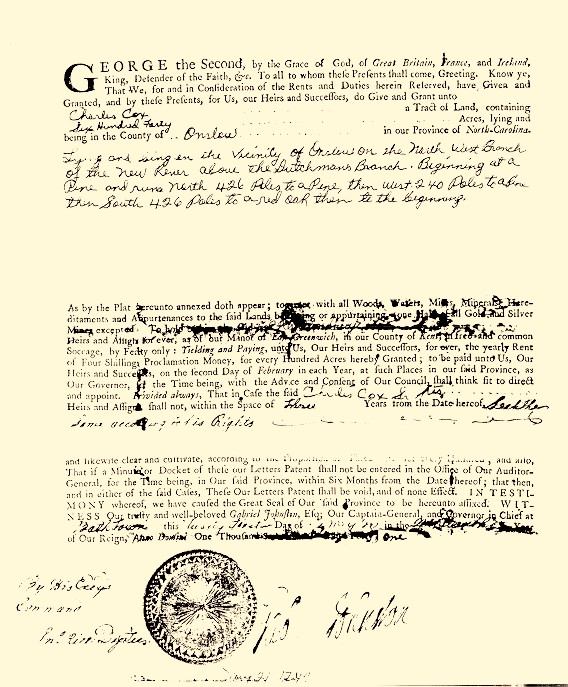
Above -- This example document has been filled with "handwriting" in recent times. The "printing" is believed to be an authentic example of the land-grant deed to colonists during the period of 1741.
See the original property description when conveyed (Handwritten notes of Woodrow W. Cox from his visits to the NC State Archives):
![]()
Last Will of
Charles Cox, 1771 (From the NC State Archives)
The following last will (an actual copy
from the State Archives) is a disturbing document giving valuable insight into the values
of that period:
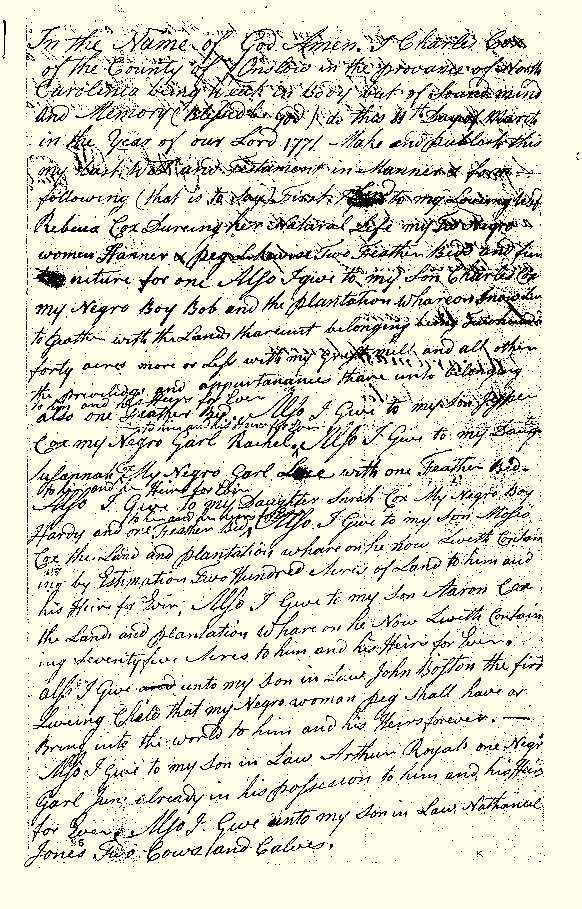
(reverse side below)
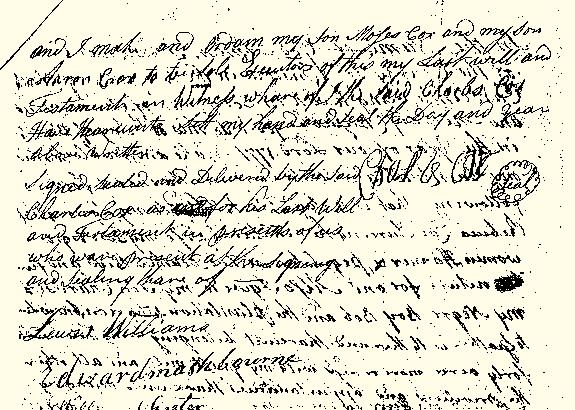
Text of the
above Last Will
(The Last Will above is an actual copy in the NC State Archives. Please
notice that named slaves were bequeathed in a very casual manner. It is chilling to image
such human property given in a document intended to honor and protect loved ones.)
In the name of God Amen, I Charles Cox of
the County of Onslow in the province of North Carolina, being weak in body but of sound
mind and memory (Blessed be God) do this 11th day of March in the year of our Lord 1771 ,
make and publish this my Last Will and Testament in manner and form following: That is to
say, first, I give to my loving wife, Rebecca Cox, during her natural life my two Negro
women Hanner and Peg; likewise two feather beds and furniture for one. Also I give to my
son, Charles Cox, my Negro boy Bob and the plantation whereon he now lives, together with
the land thereunto belonging being two hundred forty acres more or less, with my grist
mill and all other privileges and appeurtances thereunto belonging to him and his heirs
forever: also one feather bed to him and his heirs forever.
Also I give to my son Jesper Cox my Negro girl Rachel. Also I give to my daughter Susanna
my Negro girl Lue with one feather bed to her and her heirs forever. Also I give to my
daughter Sarah Cox my Negro boy Hardy and one feather bed. Also I give to my son Moses Cox
the land and plantation whereon he now liveth containing by estimation two hundred acres
of land to him and his heirs forever. Also I give to my son Aaron Cox the land and
plantation whereon he now liveth containing seventy-five acres to him and his heirs
forever. Also I give unto my son-in-law John Boston the First living child that my Negro
woman Peg shall have or bring into the world to him and his heirs forever. Also I give to
my son-in-law Arthur Royal one Negro girl Jane already in his possession to him and his
heirs forever. I also give to my son-in-law Nathan I Jones two cows and calves. I make and
order my son Moses Cox and my son Aaron Cox to be sole executors of my Last Will and
Testament.
In witness whereof, I the said
Charles Cox have hereunto set my hand and seal the day and year above written.
CHARLES COX (SEAL)
![]()
![]()
A legal
Document from 1838 (from Woodrow W. Cox collections):
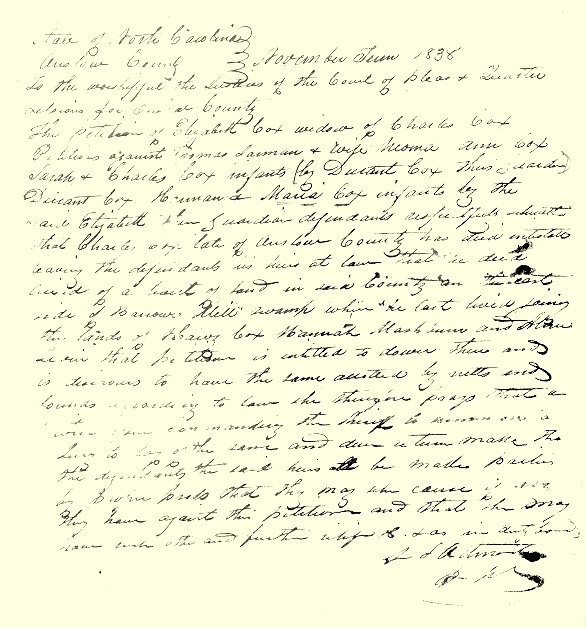
The information on the genealogy page is reprinted with permission of the family of Woodrow W. Cox from The Heritage of Onslow County © as published in 1983 by Hunter Publishing Company of Winston Salem. The publisher encouraged families in Onslow County to write educational materials about each family. The copyright is held by the Onslow County Historical Society and is reprinted here as educational materials. The family tree information and certain other information printed are public domain facts.
![]()
The Civil War For a superb National Park Web Site, See http://www.itd.nps.gov/cwss/
I have a great interest in the Civil War because of my own combat military service in Vietnam. I see no glory in the Confederate effort. The death and slaughter were senseless. That war defined our nation, abolished slavery, and had great impact on my family. Of the three Cox sons who went to fight for the cause of the Confederacy, only my Great-Grandfather, Eli Cox, survived and returned.
It is difficult to image any family sending all three sons to fight for the cause of the Confederacy, During the War, all three brothers (and all three sons of Durant Cox and Mary Jarman Cox) joined the North Carolina Thirty Fifth Regiment. See: http://www.itd.nps.gov/cwss/regiments.htm The regiment was an element of Walker's Division and was a part of General Longstreet's Corps. The Regiment served throughout the war and surrendered at Appomattox on April 9, 1865.
Charles Cox, the oldest son of Durant and Mary, was married to Orpole C. Howard on February 21, 1860 - before the war. This couple had one daughter, Sally, believed to be born in 1860 or 1861. While assigned at Drewry's Bluff, Charles was the first brother to die while in the hospital of natural causes on April 3, 1862. He is buried on the family farm in Onslow County. Drewry's Bluff was a Confederate defensive position along the James River south of Richmond and is part of the National Battlefields in the Richmond area
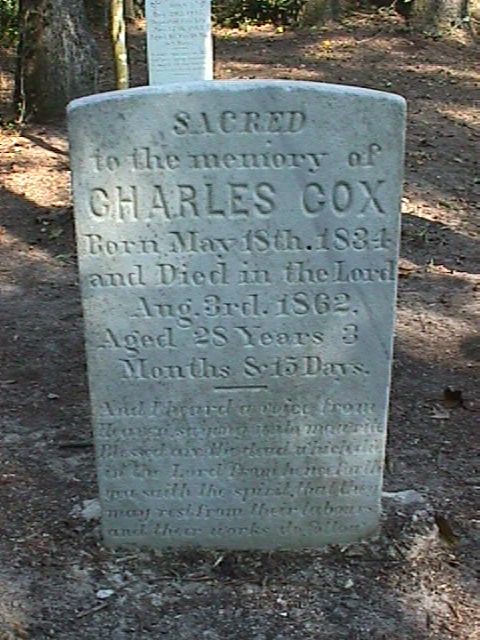
The second of the brothers to be killed was William D. Cox who joined at age 18 on April 13, 1862 (Confederate records indicate he was age 19). He was killed in night combat near Leesburg, Virginia on September 13, 1863 (1862 would seem more correct than some historical records since the Confederate army was in the vicinity of Harper's Ferry and Leesburg in 1862) and had to be abandoned by his brother, Eli. William was age 19 and single when killed. No record exists of where his body was buried.
The lone remaining son, Eli Cox, survived the Civil War even after being captured as a prisoner on March 25, 1865 in the last offensive effort of the Confederate forces attempting to prevent the fall of Petersburg at the attack on Fort Stedman. He rose to the rank of Corporal before capture.
Eli was my great Grandfather.
Before capture, he participated in the following battles and campaigns:
New Bern (March 14, 1862): http://www2.cr.nps.gov/abpp/battles/nc003.htm
Kinston (March 1862): http://www2.cr.nps.gov/abpp/battles/nc007.htm
Malvern Hill (July 1862): http://www2.cr.nps.gov/abpp/battles/va021.htm
Drewry's Bluff (August 1862, June 1863, May 1864): http://www2.cr.nps.gov/abpp/battles/va012.htm
Harper's Ferry (September 15, 1862): http://www2.cr.nps.gov/abpp/battles/wv010.htm
Antietam (September 1862): http://www2.cr.nps.gov/abpp/battles/md003.htm
Fredericksburg (December
1862): http://www2.cr.nps.gov/abpp/battles/va028.htm
The NC 35th Regt. supported
Georgia Units at the "Stonewall" at Fredericksburg against the famous
"Irish" Brigade of New York City (The New York 69th) during their brave and
heroic charge against the stonewall.
The Regiment was ordered back to North Carolina during January 1863 to May 1863 and during July 1863 to May 1864.
Eli was not a participant at Gettysburg. The 35th remained in defense of Petersburg.
Plymouth, NC (April 1864): http://www2.cr.nps.gov/abpp/battles/nc012.htm
Then on May 9th, 1864, the North Carolina 35th Regiment returned by train to the defense of Petersburg.
On
May 10 - 12, 1864, the 35th was engaged in a battle at Drewry's Bluff (the
historic defensive point held by Confederates) along the James
River South of Richmond. Eli was wounded at about that time - most likely
in that defense. His father and Mother (Durant and Mary Jarman) obtained
official permission to travel to Richmond to visit him as evidenced by the
document below (from Woodrow W. Cox's collection of materials):
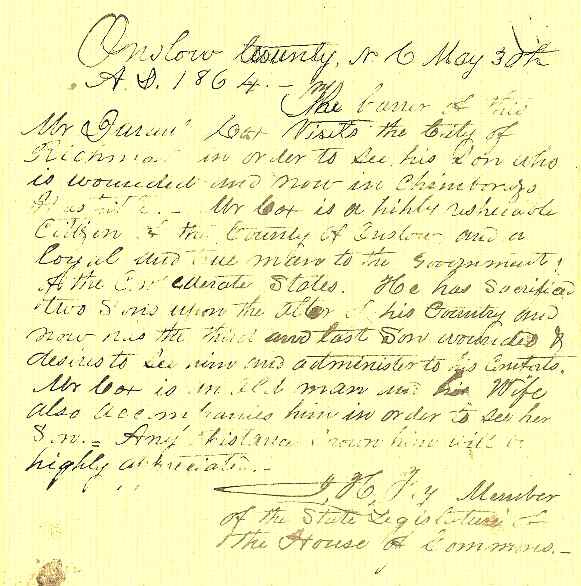
Text of above document (translated by Brenda Cox (daughter of
Joseph M. Cox Jr.) and Wendy VanAlstyne White (daughter of Eleanor Cox
VanAlstyne):
"Onslow County N.C. May 30th A.D.
1864 (initials).
The barrer [sic] of this Mr. Durant Cox visits the City of Richmond
in order to see his son who is wounded and now in Chimborazo Hospital. Mr. Cox is a
highly respectable citizen of the County of Onslow and a loyal and true man to
the government of the Confederate States. He has sacrificed two sons upon the
alter of his country and has the third and last son wounded & desires to see
him and administer to his comforts. Mr. Cox is an old man and his wife also
accompanies him in order to see her son. Any assistance will be highly
appreciated. G. H. Foy [Signature], Member of the State Legislature and the
House of Commons."
The "Crater" at Petersburg (July 1864):
http://www2.cr.nps.gov/abpp/battles/va070.htmFor a complete National Park Description of battles, see
http://www2.cr.nps.gov/abpp/battles/tvii.htmThe battle of Fort Stedman occurred on March 25, 1865 in which my great Grandfather, Eli was captured as a prisoner of war by Union Forces after being wounded in the leg during the attack. His unit, the North Carolina 35th Regiment, was assigned to attack to the north of Fort Stedman and widen the gap in Union lines as much as possible. A description of the battle is found on the website of the National Park Service for the Petersburg Battlefield. See Tour Stop 5 in the Link below:
See http://www2.cr.nps.gov/abpp/battles/va084.htm
![]()
The Regiment surrendered at Appomattox at the close of the War.
See http://www2.cr.nps.gov/abpp/battles/va097.htm
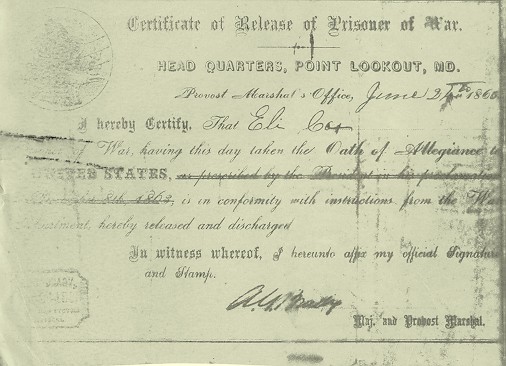
Eli Cox's Release Document as a Confederate Prisoner of War dated June 2, 1865.
He was captured on March 25, 1865 on the ill-fated Confederate attack on the Union's Fort Stedman just east of Petersburg (now in the Petersburg National Park). His unit, the North Carolina Thirty Fifth Regiment, took part in the attack with approximately 18,000 Confederates - half the Confederate force. The attack was a disaster because Fort Stedman was not easily linked to other Federal fortifications as believed. The Confederates actually captured Fort Stedman and nearby positions, but were unable to exploit nearby union trenches and rear positions. Federal forces reacted quickly and brought the captured Fort under Union artillery fire and those Confederates who attempted withdrawal back to rebel lines came under intense Federal fire. The Confederates suffered about 5,000 casualties with 1949 captured within a few hours. Union losses were put at 2,107. General Longstreet, the Confederate commander, described the attack in his book, Four Years with General Lee, as follows:
"It was a hazardous adventure at best, but [General Lee's]
brave heart went with the proposition for a bold fight."
. . .
"General Lee collected about eighteen thousand men near the sallying field, ordered
men selected to cut away the fraise and abatis for the storming column that should advance
with empty guns to avoid premature alarms."
. . .
"The stormers advanced before daylight, gained quiet possession of the enemy's
picket line, carried his works between Batteries 9 and 10, moved to the right and left,
captured Fort Stedman and its garrison, and turned the guns there and at Battery 10
against the enemy."
. . .
"Light broke and the fire opened."
. . .
"The [Union] artillery fire not only tore the Confederate ranks, but crossed fire in
their rear, cutting off reinforcements and retreat. Our side was without artillery, except
captured guns, which were handled by infantry."
. . .
"Many Confederates got back to their lines in disordered flight, but 1949 prisoners
and nine stands of colors were taken by the [Union] Ninth Corps."
. . .
"General Meade's estimate of our loss was 5,000."
(General Longstreet's book reveals no emotion about the war, but contains invaluable statistics, facts and time references.)
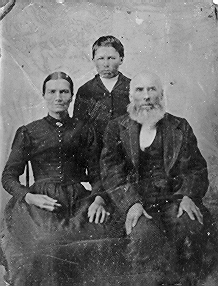
Photo of Huldah,
Arthur and Eli Cox
circa 1891
When Eli Cox returned from the Civil War in June or July 1865, he was probably in ill health due to his wounds and imprisonment as a Confederate prisoner of war when captured on March 25, 1865 during an ill-conceived Confederate attack on the Union’s Fort Stedman outside Petersburg. Eli, wounded in the leg, was one of 1949 rebel prisoners taken in that day’s attack - many of whom served with him in the North Carolina Thirty Fifth Regiment. After capture, Eli was taken to Point Lookout, Maryland where conditions were cruel, but not equal to Andersonville atrocities. At least two other prisoners at Point Lookout at the time Eli was there were residents and neighbors who lived within the Hominy Swamp area.
When Eli returned home to Onslow County, times were difficult and hard work was needed to survive. Eli’s father, Durant, died on November 17, 1867. Eli continued to operate the family farm and grist mill for his entire life while living with his Mother and older sister of the same name, Mary. Eli’s Mother died in the 1870’s and his Sister died in 1894.
Sometime after the war, Eli had a violent encounter with "carpetbaggers" at or near his farm. These persons are presumed to be Caucasian since they were never identified by race - we do not know how many there were. These individuals were killed (probably with a firearm since Eli limped on his wounded leg) and buried secretly by Eli somewhere on the Cox farm. Some historians believe that such violence was not that rare in the turbulent times after the war. Other local persons have have participated - including other prisoners who were at Point Lookout with Eli and who lived nearby. Since Arthur and his sons (the daughters were not told) later knew of this incident, it must be presumed that some neighbors knew of it and protected Eli with silence.
In about 1875, Eli married Huldah Shaw, of a local, neighborhood family. He was about 35 years old and she was about 32. After numerous miscarriages, Huldah’s only surviving son, Arthur, was born on November 25, 1877. At birth, Arthur was described as quite small and premature in weight. Huldah was devoted to Arthur as an only child.
Sometime in the 1890’s, the Cox family two-story traditional wood home burned to the ground after a kitchen fire. The family was forced to move into a three room "slavehouse" that still stands on the Cox farm.
Huldah’s half brother, Lewis Shaw, joined the Union Army during the Civil War. After the war, Lewis changed his name to Lewis Pollock and remained a resident of Pennsylvania. After the turn of the century, Lewis sent word to Huldah and Eli to re-establish family ties. Eli refused the offer.
About 1900, Arthur married Mary Elizabeth Kennedy (whose family name had been changed to Canady when they moved to Onslow County from Beaulaville). Mary and Arthur lived with Eli and Huldah. Mary and Huldah were quite close. All nine children of Arthur and Mary were born in this family house.
In his late years, Eli accepted a devout Christian life and witnessed to those who came to his mill. He never spoke of the War nor did he join any of the local veteran’s organizations. That lack of participation, plus his solo work as a miller, probably indicated symptoms of war related stress. There is no family evidence that he ever joined the Klan or took interest in such matters.
On November 1, 1912, Eli returned from early morning work at the grist mill to eat at the family home. Minutes later, he was found lying dead of natural causes by family members in the yard beside the house.
The arthritis in Huldah's hands is very evident in the photo above. Huldah, called "Grandma Huldie", continued to live with Arthur and Mary until her death on New Year’s Eve of 1931.
|
|
Family Home showing Eli, Mary,
Huldah, unknown male and Arthur. |
This unpainted,
traditional home of approximately 50 feet by 25 feet had about 2,500 square feet of space.
It was a typical structure owned by successful planters in the region. It appears that the
home had a wood foundation. There appear to be no broken windows, but there are missing
slats in the second story railing – perhaps caused by Arthur, an only child in the
home. The trees in the front appear to be fruit trees in the Spring before or as buds
developed. Orientation of the Sun’s shadow would have indicated the house faced East-
Northeast (Toward Huffman Road) and the photograph was taken in the morning. This home
burned to the ground sometime after the photograph was taken but before Arthur married
Mary Elizabeth Canady about 1900. Eli’s older sister, Mary, died in 1894. Family oral
history indicated that Huldah was in the home at the time the fire started. At risk to her
own safety, she made attempts to save family items such as the original chinaware from
England. She tossed as much as possible out the windows but most was still destroyed by
breakage or heat. History handed down later attributed the fire to Huldah’s cooking
stove when the fire went out of control. After the fire, the land where the home stood was
plowed under for crops. Woodrow W. Cox (son of Arthur and Mary) remembered that utensils
and pieces of tableware would be unearthed when he plowed that area of land as a youth in
the 1910’s.
![]()
|
|
|
|
The "slavehouse" used as a family dwelling by the family of Mary and Arthur Cox to raise nine children. Mary Cox is on the right with her infant son, Joseph. The photo appears to be taken after a winter ice storm. The house, believed to be built in the 1850's (with considerable renovations in the 1890's), still stands today on the Family farm. Left Photo circa 1902. Right photo taken in 1994.
![]()
|
|
|
|
Left: Photo of Arthur Crispus Cox when he was
a railroad employee. His
job was to sell newspapers and periodicals to passengers. He rode a train that
went through Richlands back and forth to Cove City and Hamlet, North Carolina. One
of Arthur's lifelong habits was reading newspapers and periodicals. Anthony Poe
Cox, his grandson and Reuben and Evelyn's son, tells of Arthur's strict
household rules that children could not "bother" his reading
materials. When radio reception was first available, Poe tells of how Arthur was
one of the first radio owners who loved to listen to the news. He had wires that
he installed as an antenna for better and further reception. Arthur was
considered well informed and prided himself on his knowledge of newsworthy
events. These habits may have first developed when he sold newspapers on
the railroad. Photo circa 1899
Right: Photo of Mary and Arthur Cox in the 1940's with Arthur's hunting dogs
(including
Queenie) and
his double barrel 12 gauge shotgun.
|
|
Five children of Arthur and Mary Cox (Joe, Reuben and Burma Dell were not present in photo): from left to right Hugh, Annie Mae, Esther, Julia Grace, and Woodrow photo taken at Woodrow's and Doris' 25th Wedding anniversary in 1960. |
![]()
NEW: The Loss of the Farm in the Great Depression
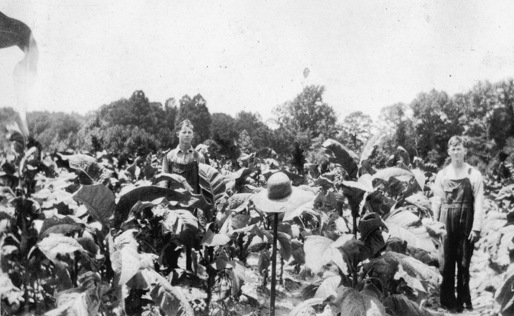
Woodrow Wilson Cox ("Bo") and Reuben
Crispus Cox (on right) in the Cox Farm tobacco fields in the 1920's. Their labor
saved the farm during the Great Depression.
In the early depression of the 1930's, the Cox family actually lost the entire farm for inability to repay a loan secured with a deed of trust owed to John Steed, a merchant in Richlands. The family never actually moved from the farm, but rented or sharecropped. Steed allowed Arthur Crispus Cox and his sons, Woodrow W. Cox ("Bo") and Reuben Crispus Cox, to repurchase the farm after about three years. This repurchase was especially humiliating to Arthur because Steed required that Bo and Reuben guarantee the debt owed. Upon repurchase, Bo and Reuben were the owners of two-thirds of the undivided interest in the farm.
Although the depression years seem recent, wives had few rights in owning or control of property.
Reuben and Woodrow ("Bo") are properly credited with saving the farm with their labor that produced the tobacco cash crop necessary to repurchase the farm. Strong feelings within the family followed because Reuben and Bo thought they were entitled to "equity" for their efforts. Both were disappointed that the other children of Arthur and Mary did not contribute as much to saving the farm. Most of these heated sibling discussions arose after Arthur's death on October 27, 1952 and Mary's Death on March 5, 1962 when the estate and Cox farm was divided among the remaining eight children as estate heirs.
The great depression and its aftermath left many emotional scars on members of the Cox family for years to come.
Reuben Crispus Cox purchased the farm in the 1960's after Arthur's death and Mary's stroke rendered her totally disabled and unable to communicate except by body signals.
![]()
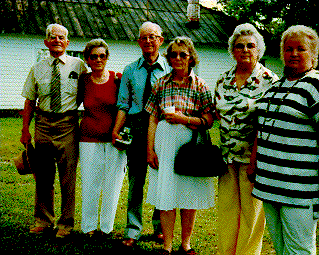
Joe, Annie Mae, Woodrow, Burma Dell, Julia
Grace and Esther in 1987
(Hugh was not present in the photo).
![]()
|
|
Adams Schoolhouse (Huffmantown Road) circa 1902: This one room school operated from about 1892 until 1924. All children of Mary and Arthur Cox were educated here. The school students still hold reunions. I attended a reunion first in 1987 - and two of the teachers were present! The color photo on the separate page was taken in 1994. The school was partially destroyed by hurricanes Bertha and Fran in 1997.
Donations can be given to help restore the school house.
Persons having history information, relics, stories, or photos about the Adams School are asked to contact Dennis E. Jones at dejones@coastalnet.com or Hugh Cox at webmaster@coxhistory.com so that a separate website with much more information can be established.
In 1987, seven of the nine children of Mary and Arthur Cox were living and were interviewed on videotape about their lives, childhood, and memories of growing up on the Cox family farm. The video contains scenes of the farm, family graveyards and buildings at that time. That two hour VHS videotape is available to interested persons. Contact
webmaster@coxhistory.com for information.Diseases that sometimes run in the family - usually at advanced age:
Diabetes mellitus: (Many of Arthur and
Mary's children had diabetes.)
Mental health stresses: (Family oral history tells that Durant would often wake up
in the night, light a lantern and awaken his sons to help him inspect his farm property
boundary markers to make certain they were in place and not disturbed. In addition, the
act of Eli attacking "carpetbaggers" would appear to an act of rage and temper.
Arthur suffered from alcohol abuse
Other Websites related to North Carolina Genealogy - especially Onslow County.
Special Thanks to MARY WESTBROOK-DRAKE for her information and efforts to gather and retain this most valuable genealogy information. Her e-mail is
marydrake@mindspring.comhttp://www.mindspring.com/~marydrake/note1.htm
Mary Westbrook-Drake's personal website - unique, creative, and refreshing.
http://www.rootsweb.com/~nconslow/onsloww.htm
Mary Westbrook-Drake's superb website on Onslow County genealogy - and other counties.
http://www.flex.net/u/golden/nc-state/
Another excellent website - and linked to the web site above.
http://posom.com/hl/usa/nc.shtml
A North Carolina genealogy website with other "links".
http://www1.linkonline.net/rodpad/genealogy.html
Rod Paderick's (of California) superb web site with Onslow County links
http://www.wisecomp.com/ccl/coxcoop.html
Andi Wise's Cox
"Co-op" of Cox's everwhere- anytime - a superb website
Other Resource Persons and Interested
Individuals:
Wynell Simpson
![]()
Cox Family
Reunion Photos of October 6, 2001 Cox Family and Friends Reunion / Picnic
![]()
This family reunion was attended by numerous individuals and organizations and was held on the Cox Farm. More than 200 attended. Dennis E. Jones, principal of Richlands High School spoke on the history of the local "Hominy Swamp Community". Local historians and re-enactors donated gravestones to replace those of five Confederate veterans whose headstones were damaged in recent hurricanes. The hosts were the children of Reuben and Evelyn Cox and their spouses.
![]()
visitors to the Cox Family
Website (plus another 25,000 since 1998).
Last updated: 08/23/11
This educational, non-profit, and genealogy web site is owned and maintained by Hugh D. Cox, PO Box 154, Greenville, NC 27835-0154 who can be contacted at
webmaster@coxhistory.com .